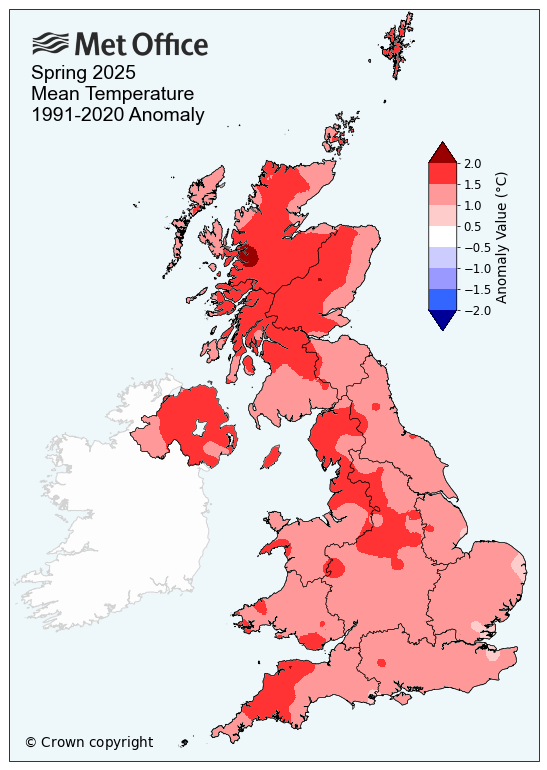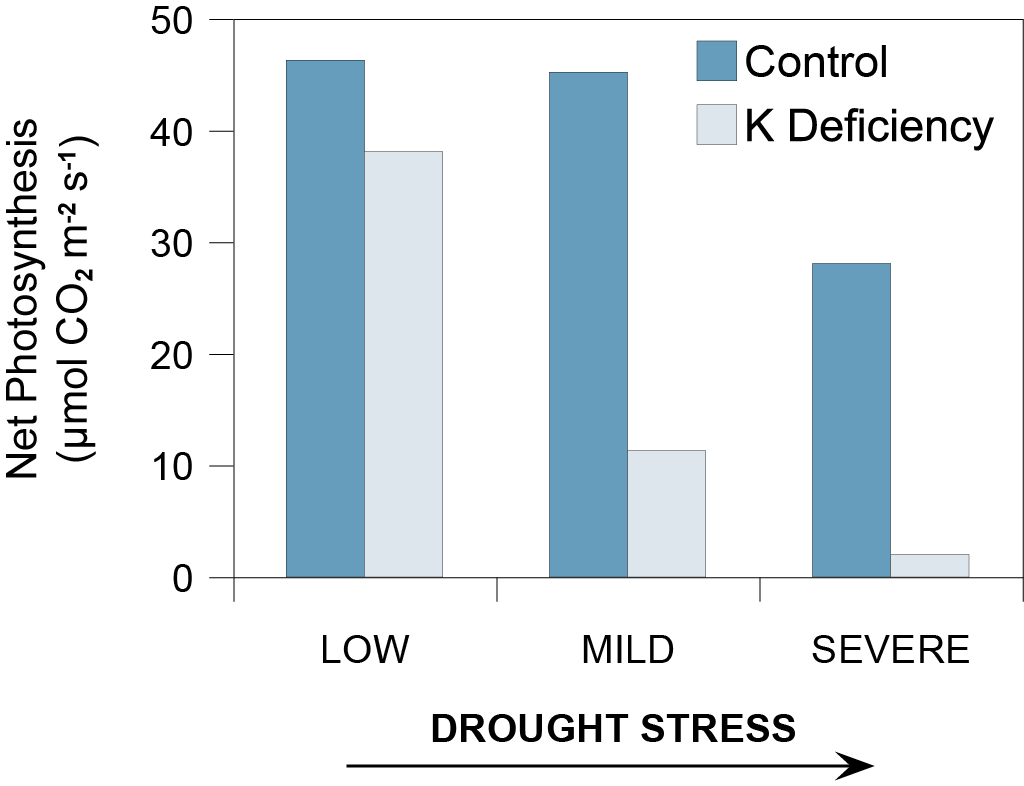Download pdf: The role of nutrition in mitigating stress (3.04M)
pdf 3.04M
The role of nutrition in mitigating stress
June 2025
Very low rainfall
With such prolonged wet conditions throughout autumn 2023 and most of 2024, it was inevitable that things would at some point reverse, just knowing when the dry spell would come and how long it would last was the major uncertainty. Up until the middle of May the UK, and England in particular, was set for the driest spring in over 100 years. Although it may not have been significant for many, the small amount of rain in the last two weeks of the month still made it the driest for 50 years and the sixth driest on record since 1836.
Not only was this spring a particularly dry one, but it has also been warmer than average with a greater number of sunshine hours than average too, as can be seen from the Met Office maps below. This combined with the low rainfall has created challenging conditions across most of the country for agriculture, something which is becoming increasingly regular.



Abiotic Stress
Extremes of all these conditions; temperature, light intensity and water availability, cause stresses on plants, which can have negative impacts on their growth and development, restricting yield and/or quality.
Nutrition plays an important role both in terms of management of crops where these stresses may occur, and to a lesser extent, but still important, alleviating the extremes. Potash is the nutrient that is often seen to have the greatest impact, but it is certainly not the only one, with sulphur, calcium and magnesium all also playing a role.
Potassium
Photosynthesis is the process by which plants capture light energy to convert carbon dioxide and water into carbohydrates, such as sugars, required for growth and building yield. The rate of photosynthesis therefore dictates the efficiency of the production of sugars and ultimately crop yield and quality. Plants subjected to stresses, such as moisture stress, considerably reduce their photosynthetic rates, reducing the efficiency of carbohydrate production resulting in lower yield. Photosynthetic rates are maintained in plants through efficient stomatal activity. Potassium is required by plants to regulate the opening and closing of the stomata (tiny apertures on the underside of leaves surrounded by guard cells).
The stomata are important for allowing the movement of carbon dioxide into the plant, whilst releasing oxygen and transpired water. The plant regulates the opening and closing of the stomata through movement of potassium into or out of the guard cells. When potassium moves into these cells, they accumulate water as a result of their higher salt concentrations (through osmosis) and therefore swell, opening the pores. If potassium levels within the plant are low, the stomata become slow to respond and do not close as quickly, resulting in the loss of water vapour and a reduced photosynthetic rate.

Negative by-products of photosynthesis are Reactive Oxygen Species (ROS), such as hydrogen peroxide, that are highly toxic and cause damage to the plant through chlorophyll degradation, leaf chlorosis and necrosis. These ROS are usually removed from plant cells by antioxidants and antioxidative enzymes, however, their production can be particularly high when plants are exposed to environmental stresses such as drought. Potassium deficient plants suffering from drought stress are therefore more susceptible to ROS damage.
High light intensity combined with drought stress can further exacerbate the problem causing very rapid leaf chlorosis and necrosis. Plants suffering from potassium deficiency are therefore also extremely sensitive to increased light intensity.
Magnesium
Magnesium is required to help plants capture the sun’s energy for growth and production through photosynthesis. Photosynthesis takes place in chlorophyll, the green pigment in plants, and magnesium is the central atom of the chlorophyll molecule, with each chlorophyll molecule containing 6.7% magnesium.
Magnesium facilitates the translocation of carbohydrates (sugars and starches), enhances the production of oils and fats, and is necessary for cell division and growth. Magnesium also plays a significant role in activating enzymes involved in respiration, photosynthesis, and nucleic acid synthesis, activating more enzymes than any other nutrient. Adequate supply helps the plant in several ways:
- formation and maintenance of chlorophyll concentration
- formation and maintenance of strong root growth
- minimised production of damaging reactive forms of oxygen (ROS)
One of the first symptoms of magnesium deficiency is a change in partitioning of dry-matter between shoots and roots. Deficiency reduces the movement of sugars out of the leaves so reducing root growth, therefore plants suffering from magnesium deficiency are less able to exploit the soil for water and nutrients. Accumulation of sugars in the leaf also inhibits the normal process of photosynthesis leading to the formation of damaging forms of reactive oxygen.
Calcium
Calcium is an essential crop nutrient vital for many aspects of crop development. Calcium plays an extremely important role in the production of plant tissue and in improving plant growth. It is required for plant cell walls and membranes, contributing to the structure of cells and holding together the cell walls of plants. Plant roots also require calcium, which is essential for the normal development of a healthy root system to ensure crops can take up the air, water, and nutrients they need from the soil.
Calcium is crucial in activating certain enzymes and for the sending of signals that coordinate certain cellular activities which is where it plays a crucial role in plant stress responses, acting as a signal to activate stress defences that help to alleviate stress symptoms. Plants experiencing abiotic stresses, such as drought or heat, can become deficient in calcium leading to the mobilisation of calcium from cell walls. This form of calcium signalling can trigger the production of protective compounds and processes that help the plant cope with the stress.
Sulphur
Sulphur is an essential plant nutrient and is necessary for protein synthesis, to maintain the balance of amino and sulphur- containing compounds. Due to the central role of both sulphur and nitrogen in the synthesis of proteins, the supplies of these nutrients in plants are highly inter-related and a shortage in the availability of sulphur will reduce the efficiency of nitrogen use.
As well as protein synthesis sulphur is essential for plants to form enzymes, vitamins, and chlorophyll. In legumes, it is crucial in nodule development and efficient nitrogen fixation and is critical for determining the nutritional quality of foods. It’s role in mitigating crop stress relates to its ability to improve the plants tolerance through the synthesis of essential amino acids, proteins, and other compounds that help plants cope with stressful conditions. Regarding drought stress, sulphur influences the production of compounds that enable the plant to better conserve water, thereby maintaining cellular activity and photosynthetic rate.
Managing Crop Stress
It can be very challenging to manage crops out of stress once this has occurred, and understanding which stresses the crop may face ahead of time can be equally challenging due to the unpredictability of the UK weather! Crops take up nutrients from soil solution, therefore drought conditions can clearly restrict nutrient uptake. Limitations to root development will exacerbate this further, as soils dry from the top down in spring, therefore deeper-rooted crops will be able to better access water, and nutrients. Although not mentioned in detail here, phosphate’s role in root growth is clearly important in the early stages of crop development, to cope with periods of dry conditions, whether temporary within the season, or more extreme.
This therefore leads back to the same solution, that crops need to be managed optimally in advance of the season. Which from a crop nutrition perspective, means ensuring that soils are maintained at the target indices for phosphate and potash (2 and 2- respectively) and have access to sufficient quantities of available calcium, magnesium and sulphur either through soil reserves or through applications of organic manures and/or fertiliser inputs.
This message is clearly not a new one, but as we move towards more unpredictable, prolonged weather conditions, which appears to be happening more frequently, it is becoming ever increasingly important to follow this tried and tested advice.
Claim your CPD Points for 2025/26
BASIS Professional Register: claim your points by e-mailing cpd@basis-reg.co.uk for year ending 31st May 2025 quoting reference:
Potash News – PN/138022/2425/g*
PDA Membership – PN/138023/2425/m*
NRoSO: claim 2 points by e-mailing nroso@basis-reg.co.uk for year ending 31st August 2025 quoting reference: NO503092f*
* BASIS are currently updating their systems so we have not been able to produce new cpd codes for the 2025/26 year yet. Once these have been generated, the online version of the newsletter will be updated.

